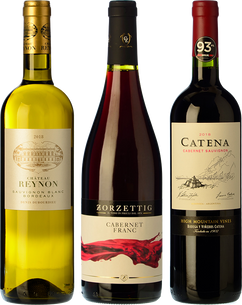| Type | Pack |
|---|---|
| Allergens | Contains sulfites |
Club Vinissimus Selection June 2021

CF+SB=CS is not a mathematical equation
CF+SB=CS is not maths, but a simple way to illustrate what Bowers and Meredith proved in 1997: the hugely popular Cabernet Sauvignon grape variety is the child of Cabernet Franc and Sauvignon Blanc. It is thought to have been the result of a chance crossing 600 years ago, or 300 according to other experts, in Bordeaux. In fact, its name is a combination of its ancestors' names which gives a clue to its origins.
Cabernet Franc originally comes from south-west France and it has become a widely-planted vine in countries like Spain and Italy in recent years. Blackish-blue grapes grow in small but long, cone-shaped, compact bunches, producing a more vigorous and productive fruit than Cabernet Sauvignon, and capable of creating much more immediate and delicate wines.
It seems likely that Sauvignon Blanc originated in the Loire valley and its name, a combination of sauvage and vignon (wild vine), is a clear reference to its domestication. It can create delightfully aromatic dry wines, as well as sweet dessert wines or white wines ideal for ageing in wood. Late to bud yet early to ripen, it prefers sunny but cool climes to warmer regions, in a similar way to its red grape relatives.
Cabernet Sauvignon is a thick-skinned variety which affects the yield of each plant as the grapes have relatively less flesh and more skin than others. It produces wines with a splendid rich colour and plentiful elegant tannins which make them ideal for a long ageing process without losing any of the grapes' primary aromas. Considered to be one of the best quality varieties, it is now widely-grown around the world.
Tasting three single-varietal wines made from Cabernet Franc, Sauvignon Blanc and Cabernet Sauvignon reveals their similarities and takes us back in time to remember that special moment when fate led to the crossing of two wild plants to create the wonderful Cabernet Sauvignon.










